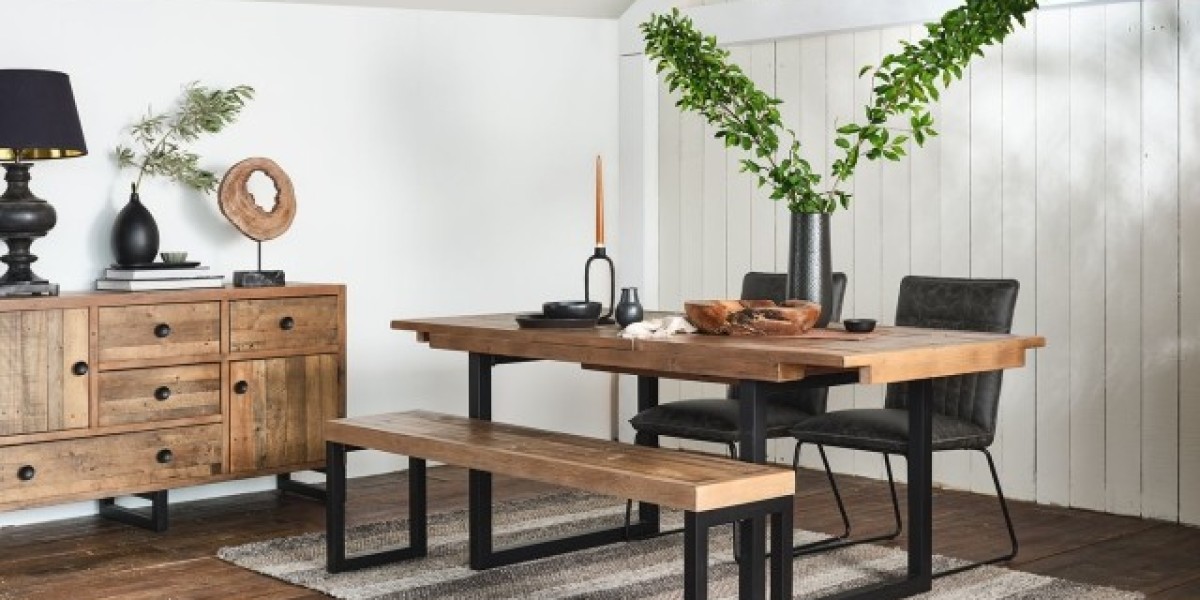In recent years, the reclaimed wood dining table has surged in popularity across the United States, and it’s no surprise why. From rustic farmhouse kitchens to modern lofts, these timeless statement pieces are transforming how Americans dine, entertain, and connect. Whether you're in a bustling city apartment or a cozy suburban home, the charm and craftsmanship of reclaimed wood bring warmth, character, and eco-conscious living to your dining space.
1. Sustainable Style That Speaks Volumes
One of the most compelling reasons for the rise of reclaimed wood furniture is its environmental benefits. Every reclaimed wood dining table embodies sustainability—crafted from salvaged boards originally sourced from old barns, factories, shipwrecks, or warehouses. By reusing these materials, U.S. consumers reduce demand for new lumber, decrease deforestation pressures, and divert waste from landfills.
Moreover, each plank tells a story through its weathered patina, knots, and grain patterns—creating a dining table that's not just functional, but also a piece of history.
2. Uniqueness That Defines Your Space
No two reclaimed wood dining tables are alike. Whether your table features nail scars from a century-old barn or intricate patterns from previous uses, its individuality sets it apart.
In American homes, where expressing personal style is key, this uniqueness is highly valued. It allows for bespoke aesthetic appeal, fitting seamlessly into rustic, farmhouse, industrial, or even contemporary interiors.
3. Durability That Stands the Test of Time
Reclaimed wood is often denser and tougher than freshly harvested timber. Having already endured decades—if not centuries—of exposure and wear, it’s naturally solid and resistant to warping or shifting.
That means a well-made reclaimed wood dining table becomes a long-term investment, likely to become a cherished heirloom that only gains character with time.
4. Warming Aesthetic for Modern American Kitchens
Open‑concept living, where the dining area merges with kitchen and living room, is a hallmark of modern American home design. A reclaimed wood dining table fits perfectly in this setting, bringing texture, warmth, and organic tones to balance sleek cabinetry, stainless steel appliances, and modern fixtures.
Its natural species-specific patinas—whether it be oak, pine, or chestnut—infuse depth and subtle earthiness that spice up minimalist or contemporary interiors without clashing.
5. Versatility in Styles & Sizes
Reclaimed wood dining tables aren’t one‑size‑fits‑all. They are available in various forms:
Farmhouse tables with trestle or X‑style legs
Industrial designs combining metal and reclaimed timber
Live‑edge slabs that preserve natural, irregular wood contours
Rustic modern pieces with clean lines paired with textured surfaces
Plus, they can be custom‑sized—from intimate four‑seaters to sprawling ten‑foot tables—perfectly accommodating American lifestyles, from intimate family meals to large holiday gatherings.
6. Alignment with Conscious Consumer Trends
U.S. consumers today gravitate toward brands and products that align with sustainability, authenticity, and craftsmanship. Reclaimed wood dining tables check all these boxes. They communicate a commitment to eco-friendly values without compromising on style.
Additionally, they support artisans who hand‑craft each tabletop. This resonates deeply with Americans seeking authenticity and stories behind the products they purchase.
7. Great ROI: Beauty, Function & Resale Value
Due to their distinct character and longevity, reclaimed wood dining tables often hold—or even appreciate—their value. In a market flooded with mass‑produced furniture, these artisanal pieces stand out.
If ever you decide to sell or pass it on, such a table is likely to attract a buyer drawn to quality, sustainability, and charm, giving it great resale potential within the U.S. furniture marketplace.
8. Emotional Connection & Legacy
Reclaimed wood often comes from materials that once lived another life—be it a centuries‑old barn, a wooden floor, or a factory loft. That imbues pieces with emotional resonance and nostalgia.
In the context of American dining culture, where meals are moments of connection, conversation, and memory‑making, a table with its own legacy enhances the experience and emotional depth of gatherings.
9. Perfect for All Decor Styles
One of the beauties of a reclaimed wood dining table lies in its chameleon‑like ability to fit into diverse decor:
Farmhouse or country style: Pairs with distressed cabinets, vintage accessories
Industrial lofts: Contrasts perfectly with concrete floors, exposed brick, metal lighting
Coastal or beach‑house vibe: Blends with light tones, wicker seats, nautical accents
Scandinavian/minimalist spaces: Adds texture to an otherwise bright, airy setup
No matter the home’s style, reclaimed wood brings grounding consistency and elegantly balances trends.
10. A Growing Movement Across the USA
Reclaimed wood furniture isn't just a niche trend—it’s gaining mainstream traction across American cities:
Urban design-conscious homeowners are choosing live-edge reclaimed tables for loft‑style dining.
In the Midwest and South, farmhouse-style reclaimed pieces pair beautifully with regional interiors.
On both coasts, eco‑conscious buyers embrace the story, character, and sustainability behind each table.
Its popularity is fueled not only by its aesthetic and environmental aspects, but also by its cultural resonance with American values of heritage, innovation, and stewardship.
Conclusion
With their unmatched blend of environmental responsibility, craftsmanship, durability, and style, reclaimed wood dining tables are more than just furniture—they’re lifestyle statements. Across the USA, homeowners are embracing these pieces to ground their design, enhance their living spaces with authenticity, and reinforce a deeper connection to both home and heritage.
No matter your décor aesthetic—be it rustic farmhouse, modern industrial, coastal chic, or Scandinavian minimalism—a reclaimed table brings enduring elegance and soulful warmth.
If you’re looking for a table that is not just functional, but also a conversation starter, a piece of history, and a sustainable choice—look toward sources like Crafts and Weavers who celebrate craftsmanship, quality, and story in every handcrafted reclaimed wood dining table.
Frequently Asked Questions (FAQ)
Q1. How do I care for and maintain a reclaimed wood dining table?
A1. Regular dusting with a soft cloth is sufficient. Use mild, non‑abrasive cleaners and avoid excessive water. Reapply appropriate wood oil or finish annually to maintain luster and protection.
Q2. Are reclaimed wood dining tables susceptible to pests?
A2. High‑quality tables are kiln‑dried and treated to eliminate pests before crafting. When buying, confirm that the wood has been properly processed to avoid concerns.
Q3. Can reclaimed wood dining tables get damaged easily?
A3. Actually, they’re known for their robustness. Minor scratches or dents add to the rustic beauty. For deeper damage, most finishes allow spot repairs or refinishing by professionals.
Q4. How do I choose the right style for my home?
A4. Consider its final location: for a modern space, a clean-lined slab works. In a rustic kitchen, a trestle or X‑leg style fits beautifully. Go by scale too—ensure the table suits the room dimensions and seating needs.
Q5. Are reclaimed wood tables more expensive?
A5. Upfront costs can be higher due to materials and craftsmanship, but you get exceptional quality and durability. Long-term, they often offer better value and longevity than mass‑produced alternatives.
Q6. Where do reclaimed wood materials come from?
A6. Sources include old barns, historic buildings, factory floors, and even ship salvage. The wood’s origin contributes to its character, grain, and coloration.
Q7. Can reclaimed wood tables be customized?
A7. Absolutely! Many artisans and U.S.-based makers offer custom sizing, leg styles, finishes, and live-edge options tailored to your design preferences and spatial needs.
Q8. Is reclaimed wood dining table good for families with kids?
A8. Yes. The sturdy construction resists wear and tear, and natural imperfections help hide minor scuffs. Plus, its timeless style can grow with your family and décor.








